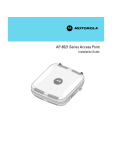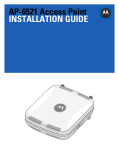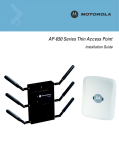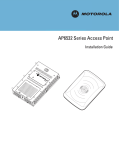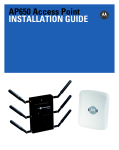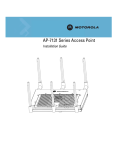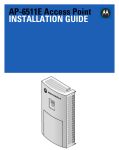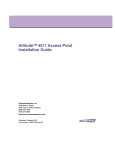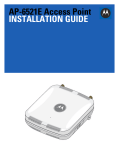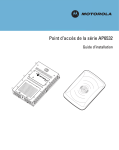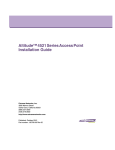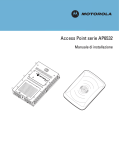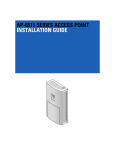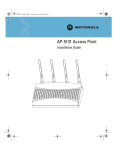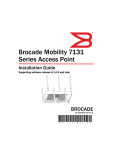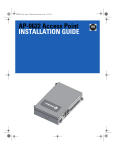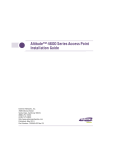Download Motorola AP-621 Series Installation guide
Transcript
AP621 IG.book Page 1 Tuesday, September 20, 2011 3:18 PM AP-621 Series Access Point Installation Guide AP621 IG.book Page 2 Tuesday, September 20, 2011 3:18 PM MOTOROLA SOLUTIONS and the Stylized M Logo are registered in the US Patent & Trademark Office. © Motorola Solutions, Inc. 2011. All rights reserved. AP621 IG.book Page 1 Tuesday, September 20, 2011 3:18 PM Table of Contents 1.0 Introduction . . . . . . . . . . . . . . . . . . . . . . . . . . . . . . . . . . . . . . . . . 1 1.1 Document Conventions . . . . . . . . . . . . . . . . . . . . . . . . . . . . . . . . . 2 1.2 Warnings . . . . . . . . . . . . . . . . . . . . . . . . . . . . . . . . . . . . . . . . . . . . 2 1.3 Site Preparation . . . . . . . . . . . . . . . . . . . . . . . . . . . . . . . . . . . . . . . 3 1.4 Package Contents . . . . . . . . . . . . . . . . . . . . . . . . . . . . . . . . . . . . . . 3 1.5 Features. . . . . . . . . . . . . . . . . . . . . . . . . . . . . . . . . . . . . . . . . . . . . . 3 2.0 Hardware Installation. . . . . . . . . . . . . . . . . . . . . . . . . . . . . . . . . 4 2.1 Installation Instructions . . . . . . . . . . . . . . . . . . . . . . . . . . . . . . . . . 4 2.2 Precautions . . . . . . . . . . . . . . . . . . . . . . . . . . . . . . . . . . . . . . . . . . . 4 2.3 Access Point Placement . . . . . . . . . . . . . . . . . . . . . . . . . . . . . . . . . 5 2.4 Wall Mount Installation . . . . . . . . . . . . . . . . . . . . . . . . . . . . . . . . . 9 2.5 Suspended Ceiling T-Bar Installation . . . . . . . . . . . . . . . . . . . . . . 11 2.6 Above the Ceiling (Plenum) Installation . . . . . . . . . . . . . . . . . . . . 13 2.7 LED Indicator . . . . . . . . . . . . . . . . . . . . . . . . . . . . . . . . . . . . . . . . . 15 3.0 Defining a Basic Configuration . . . . . . . . . . . . . . . . . . . . . . . 17 4.0 Specifications . . . . . . . . . . . . . . . . . . . . . . . . . . . . . . . . . . . . . . 18 4.1 Electrical Characteristics . . . . . . . . . . . . . . . . . . . . . . . . . . . . . . . 18 4.2 Physical Characteristics . . . . . . . . . . . . . . . . . . . . . . . . . . . . . . . . 18 4.3 Radio Characteristics . . . . . . . . . . . . . . . . . . . . . . . . . . . . . . . . . . 19 AP621 IG.book Page 2 Tuesday, September 20, 2011 3:18 PM 5.0 Regulatory Information. . . . . . . . . . . . . . . . . . . . . . . . . . . . . . . .20 6.0 Motorola’s Enterprise Mobility Support Center . . . . . . . . . .30 AP621 IG.book Page 1 Tuesday, September 20, 2011 3:18 PM Introduction 1 Introduction The AP-621 Series access point, component of Motorola Solutions Wireless Controller System, links wireless 802.11a/b/g/n devices to the controller, enabling the growth of your wireless network with a cost-effective alternative to standard access points. The AP-621 Series is an enterprise class 802.11n access point, installed in minutes anywhere a CAT-5e (or better) cable is located. An AP-621 Series access point operates in dependent mode only, and requires adoption and management by a Motorola Solutions controller to receive its configuration. An AP-621 Series access point ships with a single dual-band radio supporting the 802.11a/b/g/n radio bands. For more information on available SKUs, refer to the following: Part Number Description AP-0621-60010-US 802.11a/b/g/n single radio, integrated antenna, standard power, United States model AP-0621-60020-US 802.11a/b/g/n single radio, external antenna, standard power, United States model AP-0621-60010-WR 802.11a/b/g/n single radio, integrated antenna, standard power, World Wide model AP-0621-60020-WR 802.11a/b/g/n single radio, external antenna, standard power, World Wide model The AP-621 Series access point is approved under MODEL: NCAP-500. Motorola Solutions recommends the access point receive power and transfer data through the same CAT-5e (or better) Ethernet cable using a Motorola Solutions Power Injector. The Power Injector (Part No. AP-PSBIAS-2P2-AFR) is an 802.3af PoE injector. For information, see “Power Injector System” on page 7. A separate power supply (Part No. PWRS-147376-01R) is also available if you do not wish to use a Power Injector. This standard power supply just supplies power to the access point’s power connector and does not converge power and Ethernet within a single cable connection. The AP-621 Series access point requires adoption by a Motorola Solutions controller to receive its configurations. For information, see “Defining a Basic Configuration” on page 17. 1 AP621 IG.book Page 2 Tuesday, September 20, 2011 3:18 PM 2 AP-621 Series Access Point Installation Guide 1.1 Document Conventions The following graphical alerts are used in this guide to indicate notable situations: NOTE ! Tips, hints, or special requirements that you should take note of. CAUTION WARNING! Care is required. Disregarding a caution can result in data loss or equipment malfunction. Indicates a condition or procedure that could result in personal injury or equipment damage. 1.2 Warnings • • • Read all installation instructions and site survey reports, and verify correct equipment installation before connecting the access point. Verify any device connected to this unit is properly wired and grounded. Verify there is adequate ventilation around the device, and ambient temperatures meet equipment operation specifications. AP621 IG.book Page 3 Tuesday, September 20, 2011 3:18 PM Introduction 1.3 Site Preparation • • • • • • Consult your site survey and network analysis to determine specific equipment placement, power drops etc. Assign installation responsibility to the appropriate personnel. Identify and document where all installed components are located. Ensure adequate, dust-free ventilation to all installed equipment. Prepare Ethernet port connections. Verify cabling is within the maximum 100 meter allowable length. 1.4 Package Contents The access point ships with the following: • • • • • One AP-621 Series access point Installation Guide (This Guide) Rubber Wall Mount Spacers (4) LED light pipe and badge Wall mount screw and anchor kit 1.5 Features • • • • • • • One RJ-45 console connector One RJ-45 Ethernet connector LED Indicators Safety wire tie point Wall mount slots Clips for suspended T-Bar mounting DC power connector An AP-621 Series access point has one RJ-45 connector supporting an 10/100/1000 Ethernet port connection and requires 802.3af compliant power from an external source. The access point contains runtime firmware which enables the unit to boot after either a power up or a watchdog reset. The runtime firmware on the access point can be updated via the Ethernet interface. 3 AP621 IG.book Page 4 Tuesday, September 20, 2011 3:18 PM 4 AP-621 Series Access Point Installation Guide 2 Hardware Installation 2.1 Installation Instructions An AP-621 Series access point can attach to a wall, mount under a suspended T-Bar or mount above a ceiling. Selecting a mounting option based on the physical environment of the coverage area. Do not mount the access point in a location that has not been approved in a site survey. To prepare for an installation, perform the following: 1. Verify the contents of the box includes the intended access point and accessory hardware. 2. Review site survey and network analysis reports to determine the location and mounting position for the access point. 3. Connect a CAT-5e or better Ethernet cable to a PoE compatible device and run the cable to the installation site. Ensure there is sufficient cable slack to perform the installation steps. 4. Determine whether the access point is powered using a Power Injector system, combining data and power to the access point’s GE1/PoE port or is powered from a conventional power adapter providing power only to the access point’s DC-48V connector. 2.2 Precautions Before installing an access point: • • Verify the intended deployment location is not prone to moisture or dust. Verify the environment has a continuous temperature range between 0° C to 40° C. AP621 IG.book Page 5 Tuesday, September 20, 2011 3:18 PM Hardware Installation 2.3 Access Point Placement For optimal performance, install the access point away from transformers, heavy-duty motors, fluorescent lights, microwave ovens, refrigerators and other industrial equipment. Signal loss can occur when metal, concrete, walls or floors block transmission. Install the access point in an open area or add access points as needed to improve coverage. Antenna coverage is analogous to lighting. Users might find an area lit from far away to be not bright enough. An area lit sharply might minimize coverage and create dark areas. Uniform antenna placement in an area (like even placement of a light bulb) provides even, efficient coverage. Place the access point using the following guidelines: • • • Install the access point at an ideal height of 10 feet from the ground. Orient the access point antennas vertically for best reception. Point the access point antennas downward if attaching to the ceiling (external antenna models only). To maximize the access point’s radio coverage area, Motorola Solutions recommends conducting a site survey to define and document radio interference obstacles before installing the access point. 2.3.1 Antenna Options Motorola Solutions supports two antenna suites for the single radio, dual-band, AP-621 Series access point. One antenna suite supporting the 2.4 GHz band, and another antenna suite supporting the 5 GHz band. Select an antenna best suited to the intended operational environment of your access point. 5 AP621 IG.book Page 6 Tuesday, September 20, 2011 3:18 PM 6 AP-621 Series Access Point Installation Guide The 2.4 GHz antenna suite includes the following models: Part Number Antenna Type Approximate Gain (dBi) ML-2452-APA2-01 Dipole 3 ML-2452-HPA5-036 Dipole 2.9 ML-2499-HPA3-01R Dipole 4.6 ML-2499-APA2-01R Dipole 2 ML-2452-APA2GA1-01 Dipole 2 ML-2452-PNA5-01R Panel 4.5 ML-2452-PTA3M3-36 Patch 5 ML-2499-SD3-01R Patch 4.8 Internal Antenna PIFA 2.4 AP621 IG.book Page 7 Tuesday, September 20, 2011 3:18 PM Hardware Installation The 5 GHz antenna suite includes the following models: Part Number Antenna Type Approximate Gain (dBi) ML-2452-APA2-01 Dipole 5 ML-2452-HPA5-036 Dipole 4.9 ML-5299-APA1-01R Dipole 2 ML-5299-HPA1-01R Dipole 5 ML-2452-APA2GA1-01 Dipole 1 ML-2452-PNA5-01R Panel 5 ML-2452-PTA3M3-36 Patch 3 ML-5299-PTA1-0R Patch 5 Internal Antenna PIFA 5.3 For a more exhaustive overview of the antennas and associated components supported by the Motorola Solutions access point family, refer to the Enterprise Wireless LAN Antenna Specification Guide available at http://support.symbol.com/support/product/manuals.do. 2.3.2 Power Injector System The access point can receive power via an Ethernet cable connected to the GE1/PoE port. When users purchase a WLAN solution, they often need to place access points in obscure locations. In the past, a dedicated power source was required for each access point in addition to the Ethernet infrastructure. This often required an electrical contractor to install power drops at each access point location. The Power Injector merges power and Ethernet into one cable, reducing the burden of installation and allowing optimal access point placement in respect to the intended coverage area. The Power Injector (Part No. AP-PSBIAS-2P2-AFR) is an 802.3af PoE injector. The access point can only use a Power Injector when connecting to the access point’s GE1/PoE port. The Power Injector is separately ordered and not shipped with the access point. A separate Power Injector is required for each access point comprising the network. The Power Injector has no On/Off power switch. The Injector receives power and is ready for device connection and operation as soon as AC power is applied. Refer to the guide shipped with the Power Injector for a description of the device’s LEDs. The Power Injector can be installed free standing, on an even horizontal surface or wall mounted using the Power Injector’s wall mounting key holes. 7 AP621 IG.book Page 8 Tuesday, September 20, 2011 3:18 PM 8 AP-621 Series Access Point Installation Guide The following guidelines should be adhered to before cabling the Power Injector to an Ethernet source and an access point: • • • • Do not block or cover airflow to the Power Injector. Keep the Power Injector away from excessive heat, humidity, vibration and dust. The Power Injector isn’t a repeater, and does not amplify the Ethernet signal. For optimal performance, ensure the Power Injector is placed as close as possible to the Ethernet switch. This allows the access point to be deployed away from power drops. Ensure the cable length from the Ethernet source (host) to the Power Injector and access point does not exceed 100 meters (333 ft). AP621 IG.book Page 9 Tuesday, September 20, 2011 3:18 PM Hardware Installation ! ! CAUTION To avoid problematic performance and restarts, disable PoE from a wired controller port connected to an access point if mid-span power sourcing equipment (PSE) is used between the two, regardless of the manufacturer. CAUTION Ensure AC power is supplied to the Power Injector using an AC cable with an appropriate ground connection approved for the country of operation. NOTE If not using the Power Injector to power the access point, the only other approved power solution is the standard power supply (Part Number PWRS-147376-01R). The standard power supply does not converge data and power in one cable, and requires a separate data Ethernet connection in addition to a power connection. This product is intended to be supplied by a listed power adapter marked “Class 2” or “L.P.S” (or “Limited Power Source”) and rated from 48Vdc, 0.27A minimum. 2.4 Wall Mount Installation To support wall mount installations, the access point is fastened directly to a flat wall surface. The wall should be of gypsum board, plaster, wood or concrete in composition. ! CAUTION An access point should be wall mounted to concrete or plasterwall-board (dry wall) only. Do not wall mount the access point to combustible surfaces. To install the access point to a wall: 1. Orient the access point by either its width or length. 2. Mark the mounting surface at the target screw insertion points. 3. At each point, drill a hole in the wall, insert an anchor, screw into the anchor the wall mounting screw and stop when there is 1mm between the screw head and the wall. If pre-drilling a hole, the recommended hole size is 2.8mm (0.11in.) if the screws are going directly into the wall and 6mm (0.23in.) if wall anchors are being used. 4. If required, install and attach a security cable to the access point lock port. 9 AP621 IG.book Page 10 Tuesday, September 20, 2011 3:18 PM 10 AP-621 Series Access Point Installation Guide 5. Attach the antennas to their correct connectors. For information on available antennas, see “Antenna Options” on page 5. 6. Place the large center opening of each of the mount slots over the screw heads. 7. Slide the access point down along the mounting surface to hang the mount slots on the screw heads 8. Cable the access point using either the Power Injector or an approved line cord and power supply. ! CAUTION Do not connect to the power source until the cabling of the access point is complete. Ensure PoE is not connected to the access point’s console connector or risk rendering the console connector permanently inoperable. For Motorola Power Injector installations: a. Connect a RJ-45 CAT5e (or CAT6) Ethernet cable between the network data supply (host) and the Power Injector Data In connector. b. Connect a RJ-45 CAT5e (or CAT6) Ethernet cable between the Power Injector Data & Power Out connector and the access point GE1/PoE port. c. Ensure the cable length from the Ethernet source (host) to the Power Injector and access point does not exceed 100 meters (333 ft). The Power Injector has no On/Off power switch. The Power Injector receives power as soon as AC power is applied. For more information on using the Power Injector, see “LED Indicator” on page 15. For power adapter (Part Number PWRS-147376-01R) and line cord installations: a. Connect a RJ-45 CAT5e (or CAT6) Ethernet cable between the network data supply (host) and the access point’s GE1/PoE. b. Verify the power adapter is correctly rated according the country of operation. c. Connect the power supply line cord to the power adapter. d. Attach the power adapter cable to the DC-48V power connector on the access point. e. Attach the power supply line cord to a power supply. 9. Verify the behavior of the LEDs. For more information, see “LED Indicator” on page 15. AP621 IG.book Page 11 Tuesday, September 20, 2011 3:18 PM Hardware Installation 10. The access point is ready to configure. For information on basic access point device configuration, see “Defining a Basic Configuration” on page 17. 2.5 Suspended Ceiling T-Bar Installation A suspended ceiling mount requires holding the access point up against the T-bar of a suspended ceiling grid and twisting the access point chassis onto the T-bar. To install the access point on a ceiling T-bar: 1. If desired, install and attach a security cable to the access point lock port. 2. If using an external antenna model, attach the antennas to their correct connectors. 3. For more information on the antenna options available to the access point, see “Antenna Options” on page 11. 4. Cable the access point using either the Power Injector solution or an approved line cord and power supply. ! CAUTION Do not connect to the power source until the cabling of the access point is complete. Ensure PoE is not connected to the access point’s console connector or risk rendering the console connector permanently inoperable. For Power Injector installations: a. Connect a RJ-45 CAT5e (or CAT6) Ethernet cable between the network data supply (host) and the Power Injector Data In connector. b. Connect a RJ-45 CAT5e (or CAT6) Ethernet cable between the Power Injector Data & Power Out connector and the access point’s GE1/PoE port. c. Ensure the cable length from the Ethernet source (host) to the Power Injector and access point does not exceed 100 meters (333 ft). The Power Injector has no On/Off power switch. The Power Injector receives power as soon as AC power is applied. For more information on using the Power Injector, see “Power Injector System” on page 7. For power adapter (Part Number PWRS-147376-01R) and line cord installations: a. Connect a RJ-45 Ethernet cable between the network data supply (host) and the access point’s GE1/PoE port. b. Verify the power adapter is correctly rated according the country of operation. 11 AP621 IG.book Page 12 Tuesday, September 20, 2011 3:18 PM 12 AP-621 Series Access Point Installation Guide c. Connect the power supply line cord to the power adapter. d. Attach the power adapter cable to the DC-48V power connector on the access point. e. Attach the power supply line cord to a power supply. 5. Verify the behavior of the access point LEDs. For more information, see “LED Indicator” on page 15. 6. Align the bottom of the ceiling T-bar with the back of the access point. 7. Orient the access point chassis by its length and the length of the ceiling T-bar. 8. Rotate the access point chassis 45 degrees clockwise. 9. Push the back of the access point chassis on to the bottom of the ceiling T-bar. 10. Rotate the access point chassis 45 degrees counter-clockwise. The clips click as they fasten to the T-bar. 11. Verify the behavior of the LEDs. For more information, see “LED Indicator” on page 15. 12. The access point is ready to configure. For information on basic access point device configuration, see “Defining a Basic Configuration” on page 17. AP621 IG.book Page 13 Tuesday, September 20, 2011 3:18 PM Hardware Installation 2.6 Above the Ceiling (Plenum) Installation An above the ceiling installation requires placing the access point above a suspended ceiling and installing the provided light pipe under the ceiling tile for viewing the status LED of the unit. An above the ceiling installation enables installations compliant with drop ceilings, suspended ceilings and industry standard tiles from .625 to .75 inches thick. NOTE ! The access point is Plenum rated to UL2043 and NEC1999 to support above the ceiling installations. To ensure UL compliance and proper access point operation within the Air Handling Plenum, the access point must be installed with the bottom surface of the unit in contact with the un-finished surface of the ceiling tile. Placing the product on the ceiling tile will facilitate the positioning of the light pipe. Placement of the product in the Air Handling Plenum off of, or away from, the unfinished surface of the ceiling tile is not UL approved and certification of UL2043 compliance would be void in that case. CAUTION Motorola Solutions does not recommend mounting the access point directly to suspended ceiling tile with a thickness less than 12.7mm (0.5in.) or a suspended ceiling tile with an unsupported span greater than 660mm (26in.). The mounting hardware required to install the access point above a ceiling consists of: • • • Light pipe Badge for light pipe Decal for badge To install the access point above a ceiling: 1. 2. 3. 4. 5. ! If possible, remove the adjacent ceiling tile from its frame and place it aside. If required, install and attach a security cable to the access point’s lock port. Mark a point on the finished side of the tile where the light pipe is to be located. Create a light pipe path hole in the target position on the ceiling tile. Use a drill to make a hole in the tile the approximate size of the access point LED light pipe. CAUTION Motorola Solutions recommends care be taken not to damage the finished surface of the ceiling tile when creating the light pipe hole and installing the light pipe. 13 AP621 IG.book Page 14 Tuesday, September 20, 2011 3:18 PM 14 AP-621 Series Access Point Installation Guide 6. Remove the light pipe’s rubber stopper (from the access point) before installing the light pipe. 7. Connect the light pipe to the bottom of the access point. Align the tabs and rotate approximately 90 degrees. Do not over tighten. 8. Fit the light pipe into hole in the tile from its unfinished side. 9. Place the decal on the back of the badge and slide the badge onto the light pipe from the finished side of the tile. 10. Attach the antennas to their correct connectors. For information on the antennas available to the access point, see “Antenna Options” on page 5. 11. Align the ceiling tile into its former ceiling space. 13. Cable the access point using either the Power Injector solution or an approved line cord and power supply. ! CAUTION Do not connect to the power source until the cabling of the access point is complete. Ensure PoE is not connected to the access point’s console connector or risk rendering the console connector permanently inoperable For Power Injector installations: a. Connect a RJ-45 CAT5e (or CAT6) Ethernet cable between the network data supply (host) and the Power Injector Data In connector. b. Connect a RJ-45 CAT5e (or CAT6) Ethernet cable between the Power Injector Data & Power Out connector and the access point’s GE1/PoE port. c. Ensure the cable length from the Ethernet source (host) to the Power Injector and access point does not exceed 100 meters (333 ft). The Power Injector has no On/Off power switch. The Power Injector receives power as soon as AC power is applied. For more information on using the Power Injector, see “Power Injector System” on page 7. For power adapter (Part Number PWRS-147376-01R) and line cord installations: a. Connect a RJ-45 Ethernet cable between the network data supply (host) and the access point’s GE1/PoE port. b. Verify the power adapter is correctly rated according the country of operation. c. Connect the power supply line cord to the power adapter. d. Attach the power adapter cable to the DC-48V power connector on the access point. AP621 IG.book Page 15 Tuesday, September 20, 2011 3:18 PM Hardware Installation e. Attach the power supply line cord to a power supply. 12. Verify the behavior of the access point LED light pipe. For more information, see “LED Indicator” on page 15. 13. Place the ceiling tile back in its frame and verify it is secure. 14. The access point is ready to configure. For information on basic access point device configuration, see “Using the Initial Setup Wizard” on page 17. 2.7 LED Indicator An AP-621 Series access point has a single LED activity indicator on the front of the access point. The LED provides a status display indicating error conditions, transmission, and network activity for the 5 GHz 802.11a/n (amber) radio or the 2.4 GHz 802.11b/g/n (green) radio. 15 AP621 IG.book Page 16 Tuesday, September 20, 2011 3:18 PM 16 AP-621 Series Access Point Installation Guide Task 5 GHz Activity LED (Amber) 2.4 GHz Activity LED (Green) Unadopted Off Blinking 5 times per second Normal Operation • If this radio band is enabled: Blink at 5 second interval • If this radio band is disabled: Off • If there is activity on this band: Blink at a 1Hz • If this radio band is enabled: Blink at 5 second interval • If this radio band is disabled: Off • If there is activity on this band: Blink at a 1Hz Firmware Update On Off Locate AP Mode Blink at 5Hz Blink at 5Hz AP621 IG.book Page 17 Tuesday, September 20, 2011 3:18 PM Defining a Basic Configuration 3 Defining a Basic Configuration An AP-621 Series access point receives its configuration when adopted by a Motorola Solutions RFS controller. Adoption is the process an access point uses to discover controllers available in the network, pick the most desirable controller, establish an association and obtain a configuration. For information on preparing a controller for AP-621 Series access point adoption, refer to the Motorola Solutions Wireless Services Controller System Reference Guide, available at http://support.symbol.com/support/product/manuals.do. 17 AP621 IG.book Page 18 Tuesday, September 20, 2011 3:18 PM 18 AP-621 Series Access Point Installation Guide 4 Specifications 4.1 Electrical Characteristics An AP-621 Series access point has the following electrical characteristics: Max DC Power Consumption 12.95W (270mA@48V) 4.2 Physical Characteristics An AP-621 Series access point has the following physical characteristics: Dimensions 6.0 (Length) x 5.5 (Width) x 1.63 (Tall) - Inches 152.4 (Length) x 139.7 (Width) x 41.1 (Tall) - Millimeters Housing Plastic Weight 0.60 lbs/0.272 kg Operating Temperature 32°F to 104°F/0°C to 40°C Storage Temperature -40°F to 158°F/-40°C to 70°C Operating Humidity 5 to 95% Relative Humidity non-condensing Storage Humidity 85% Relative Humidity non-condensing Operating Altitude (max) 8,000 ft @ 28°C Storage Altitude (max) 30,000 ft @ 12°C Electrostatic Discharge +/-15kV Air and +/-8kV Contact @ 50% Relative Humidity AP621 IG.book Page 19 Tuesday, September 20, 2011 3:18 PM Specifications 4.3 Radio Characteristics An AP-621 Series access point has the following radio characteristics: Radio Characteristic AP-621 Standard Power Operating Channel (2.4 GHz) Channel 1 to 13 (2412 to 2472 MHz) Operating Channel (5.2 GHz) Channels 36 to 48; channels 149 - 165 802.11a Data Rates 6, 9, 12, 18, 24, 36, 48, 54 Mbps 802.11b Data Rates 1, 2, 5.5, 11 Mbps 802.11g Data Rates 6, 9, 12, 18, 24, 36, 48, 54 Mbps 802.11n Data Rates MCS0 to MCS15 at both HT20 and HT40 modes Max Transmit Power (2.4GHz) 24 dBm Max Transmit Power (5.2 GHz) 20 dBm Transmit Power Adjustment 1 dB 19 AP621 IG.book Page 20 Tuesday, September 20, 2011 3:18 PM 20 AP-621 Series Access Point Installation Guide 5 Regulatory Information 5.1 Regulatory Overview This device is approved under the Motorola Solutions brand. This guide applies to Part Numbers AP-0621-60010-US, AP-0621-60020-US, AP-0621-60010-WR, and AP-0621-60020-WR. AP-621 Series access points are approved under MODEL: NCAP-500. All Motorola Solutions devices are designed to be compliant with rules and regulations in locations they are sold and will be labeled as required. Any changes or modifications to Motorola Solutions equipment, not expressly approved by Motorola Solutions, could void the user’s authority to operate the equipment. Motorola Solutions Access Points must be professionally installed and configured so that the Radio Frequency Output Power will not exceed the maximum allowable limit for the country of operation. Antennas: Use only the supplied or an approved replacement antenna. Unauthorized antennas, modifications, or attachments could cause damage and may violate regulations. Use of an unapproved antenna is illegal under FCC regulations subjecting the end user to fines and equipment seizure. 5.2 Wireless Device Country Approvals Regulatory markings, subject to certification, are applied to the device signifying the radio(s) is/are approved for use in the following countries: United States, Canada, Japan, China, S. Korea, Australia, and Europe. Please refer to the Declaration of Conformity (DoC) for details of other country markings. This is available at http://www.motorola.com/Business/US-EN/Document+Library/Declaration+of+Conformity Note: For 2.4GHz or 5GHz Products: Europe includes, Austria, Belgium, Bulgaria, Czech Republic, Cyprus, Denmark, Estonia, Finland, France, Germany, Greece, Hungary, Iceland, Ireland, Italy, Latvia, Liechtenstein, Lithuania, Luxembourg, Malta, Netherlands, Norway, Poland, Portugal, Romania, Slovak Republic, Slovenia, Spain, Sweden, Switzerland and the United Kingdom. Operation of the device without regulatory approval is illegal. 5.2.1 Country Selection – Note for AP & Wireless Controller Select only the country in which you are using the device. Any other selection will make the operation of this device illegal. The US version of the Access Point will only have US listed in the country AP621 IG.book Page 21 Tuesday, September 20, 2011 3:18 PM Regulatory Information selection table. The US version will be sold / used in the US protectorates: American Samoa, Guam, Puerto Rico, US Virgin Islands. 5.2.2 Frequency of Operation – FCC and IC 5 GHz Only The use on UNII (Unlicensed National Information Infrastructure) Band 1 5150-5250 MHz and Band 3 5470 - 5725 MHz is restricted to indoor use only, any other use will make the operation of this device illegal. Devices using the 5470 – 5725 MHz band shall not be capable of transmitting in the band 5600 - 5650 MHz in the US, this “Notched” band has been disabled in the US version of the Access Point. 2.4 GHz Only The available channels for 802.11 b/g operation in the US are Channels 1 to 11. The range of channels is limited by firmware. 5.3 Health and Safety Recommendations 5.3.1 Warnings for the use of Wireless Devices Please observe all warning notices with regard to the usage of wireless devices 5.3.2 Potentially Hazardous Atmospheres – Fixed Installations You are reminded of the need to observe restrictions on the use of radio devices in fuel depots, chemical plants etc. and areas where the air contains chemicals or particles (such as grain, dust, or metal powders). 5.3.3 Safety in Hospitals Wireless devices transmit radio frequency energy and may affect medical electrical equipment. When installed adjacent to other equipment, it is advised to verify that the adjacent equipment is not adversely affected. 21 AP621 IG.book Page 22 Tuesday, September 20, 2011 3:18 PM 22 AP-621 Series Access Point Installation Guide Pacemakers Pacemaker manufacturers recommended that a minimum of 15cm (6 inches) be maintained between a handheld wireless device and a pacemaker to avoid potential interference with the pacemaker. These recommendations are consistent with independent research and recommendations by Wireless Technology Research. Persons with Pacemakers: • • • • Should ALWAYS keep the device more than 15cm (6 inches) from their pacemaker when turned ON. Should not carry the device in a breast pocket. Should use the ear furthest from the pacemaker to minimize the potential for interference. If you have any reason to suspect that interference is taking place, turn OFF your device. Other Medical Devices Please consult your physician or the manufacturer of the medical device, to determine if the operation of your wireless product may interfere with the medical device. 5.4 RF Exposure Guidelines 5.4.1 Safety Information Reducing RF Exposure—Use Properly Only operate the device in accordance with the instructions supplied. 5.5 International The device complies with internationally recognized standards covering human exposure to electromagnetic fields from radio devices. For information on “International” human exposure to eletromagnic fields refer to the Motorola Solutions Declaration of Conformity (DoC) at http://www.motorola.com/Business/US-EN/Document+Library/Declaration+of+Conformity 5.6 EU Remote and Standalone Antenna Configurations To comply with EU RF exposure requirements, antennas that are mounted externally at remote locations or operating near users at stand-alone desktop of similar configurations must operate with a minimum separation distance of 20 cm from all persons. AP621 IG.book Page 23 Tuesday, September 20, 2011 3:18 PM Regulatory Information 5.7 US and Canada Co-located statement To comply with FCC RF exposure compliance requirements, the antennas used with this transmitter must not be co-located, or operating in conjunction, with any other transmitter/antenna except those already approved in this filling. Remote and Standalone Antenna Configurations To comply with FCC RF exposure requirements, antennas that are mounted externally at remote locations or operating near users at stand-alone desktop of similar configurations must operate with a minimum separation distance of 20 cm from all persons. 5.8 Power Supply This device is powered from either a model PWRS-147376-01R 48 volt power supply or a 802.3af compliant power source which is UL approved and certified by the appropriate agencies. 5.9 Radio Frequency Interference Requirements—FCC This equipment has been tested and found to comply with the limits for a Class B digital device, pursuant to Part 15 of the FCC rules. These limits are designed to provide reasonable protection against harmful interference in a residential installation. This equipment generates, uses and can radiate radio frequency energy and, if not installed and used in accordance with the instructions, may cause harmful interference to radio communications. However there is no guarantee that interference will not occur in a particular installation. If this equipment does cause harmful interference to radio or television reception, which can be determined by turning the equipment off and on, the user is encouraged to try to correct the interference by one or more of the following measures: • • • Increase the separation between the equipment and receiver Connect the equipment into an outlet on a circuit different from that to which the receiver is connected Consult the dealer or an experienced radio/TV technician for help Radio Transmitters (Part 15) This device complies with Part 15 of the FCC Rules. Operation is subject to the following two conditions: (1) this device may not cause harmful interference, and (2) this device must accept any interference received, including interference that may cause undesired operation. Restricted Band 5.60 – 5.65 GHz 23 AP621 IG.book Page 24 Tuesday, September 20, 2011 3:18 PM 24 AP-621 Series Access Point Installation Guide 5.10 Radio Frequency Interference Requirements – Canada This Class B digital apparatus complies with Canadian ICES-003. Cet appareil numérique de la classe B est conforme à la norme NMB-003 du Canada. 5.10.1 Radio Transmitters For RLAN Devices: The use of 5 GHz RLAN’s, for use in Canada, have the following restrictions: • Restricted Band 5.60 – 5.65 GHz This device complies with RSS 210 of Industry & Science Canada. Operation is subject to the following two conditions: (1) this device may not cause harmful interference and (2) this device must accept any interference received, including interference that may cause undesired operation. Label Marking: The Term "IC:" before the radio certification only signifies that Industry Canada technical specifications were met. 5.11 CE Marking and European Economic Area (EEA) The use of 2.4 GHz RLAN’s, for use through the EEA, have the following restrictions: • • • Maximum radiated transmit power of 100 mW EIRP in the frequency range 2.400 -2.4835 GHz. France, outside usage is restricted to 2.4 – 2.454 GHz. Italy requires a user license for outside usage. 5.12 Statement of Compliance Motorola Solutions hereby, declares that this device is in compliance with the essential requirements and other relevant provisions of Directive 1999/5/EC. A Declaration of Conformity may be obtained from http://www.motorola.com/Business/US-EN/Document+Library/Declaration+of+Conformity. AP621 IG.book Page 25 Tuesday, September 20, 2011 3:18 PM Regulatory Information 5.13 Waste Electrical and Electronic Equipment (WEEE) English: For EU Customers: All products at the end of their life must be returned to for recycling. For information on how to return product, please go to: http://www.symbol.com/environmental_compliance. Dansk: Til kunder i EU: Alle produkter skal returneres til Symbol til recirkulering, når de er udtjent. Læs oplysningerne om returnering af produkter på: http://www.symbol.com/ environmental_compliance. Deutsch: Für Kunden innerhalb der EU: Alle Produkte müssen am Ende ihrer Lebensdauer zum Recycling an Symbol zurückgesandt werden. Informationen zur Rücksendung von Produkten finden Sie unter http://www.symbol.com/environmental_compliance. Eesti: EL klientidele: kõik tooted tuleb nende eluea lõppedes tagastada taaskasutamise eesmärgil Symbol'ile. Lisainformatsiooni saamiseks toote tagastamise kohta külastage palun aadressi: http://www.symbol.com/environmental_compliance. Español: Para clientes en la Unión Europea: todos los productos deberán entregarse a Symbol al final de su ciclo de vida para que sean reciclados. Si desea más información sobre cómo devolver un producto, visite: http://www.symbol.com/environmental_compliance. Français : Clients de l'Union Européenne : Tous les produits en fin de cycle de vie doivent être retournés à Symbol pour recyclage. Pour de plus amples informations sur le retour de produits, consultez : http://www.symbol.com/environmental_compliance. Italiano: per i clienti dell'UE: tutti i prodotti che sono giunti al termine del rispettivo ciclo di vita devono essere restituiti a Symbol al fine di consentirne il riciclaggio. Per informazioni sulle modalità di restituzione, visitare il seguente sito Web: http://www.symbol.com/ environmental_compliance. Magyar: Az EU-ban vásárlóknak: Minden tönkrement terméket a Symbol vállalathoz kell eljuttatni újrahasznosítás céljából. A termék visszajuttatásának módjával kapcsolatos tudnivalókért látogasson el a http://www.symbol.com/environmental_compliance weboldalra 25 AP621 IG.book Page 26 Tuesday, September 20, 2011 3:18 PM 26 AP-621 Series Access Point Installation Guide Nederlands: Voor klanten in de EU: alle producten dienen aan het einde van hun levensduur naar Symbol te worden teruggezonden voor recycling. Raadpleeg http://www.symbol.com/ environmental_compliance voor meer informatie over het terugzenden van producten. Português: Para clientes da UE: todos os produtos no fim de vida devem ser devolvidos à Symbol para reciclagem. Para obter informações sobre como devolver o produto, visite: http:/ /www.symbol.com/environmental_compliance. Slovenski: Za kupce v EU: vsi izdelki se morajo po poteku življenjske dobe vrniti podjetju Symbol za reciklažo. Za informacije o vraèilu izdelka obišèite: http://www.symbol.com/ environmental_compliance. Suomi: Asiakkaat Euroopan unionin alueella: Kaikki tuotteet on palautettava kierrätettäväksi Symbol-yhtiöön, kun tuotetta ei enää käytetä. Lisätietoja tuotteen palauttamisesta on osoitteessa http://www.symbol.com/environmental_compliance. 5.14 TURKISH WEEE Statement of Compliance EEE Yönetmeliğine Uygundur 5.15 Japan (VCCI) - Voluntary Control Council for Interference Class B ITE この装置は、情報処理装置等電波障害自主規制協議会 (VCCI)の基準に基づくク ラス B 情報技術装置です。この装置は、家庭環境で使用することを目的としています が、この装置がラジオやテレビジョン受信機に近接して使用されると、受信障害を引 き起こすことがあります。取扱説明書に従って正しい取り扱いをして下さい。 This is a Class B product based on the standard of the Voluntary Control Council for Interference from Information Technology Equipment (VCCI). If this is used near a radio or television receiver in a domestic environment, it may cause radio interference. Install and use the equipment according to the instruction manual. AP621 IG.book Page 27 Tuesday, September 20, 2011 3:18 PM Regulatory Information 5.16 Korea Warning Statement for Class B ITE 기종별 B 급 기기 ( 가정용 방송통신기기 ) 사용자안내문 이 기기는 가정용 (B 급 ) 으로 전자파적합등록을 한 기기로서 주로 가정에서 사용하는 것을 목적 으로 하며 , 모든 지역에서 사용할 수 있습니다 . Class B (Broadcasting This device obtained EMC registration mainly for home use Communication Device for Home (Class B) and may be used in all areas. Use) 5.17 Other Countries 5.17.1 Australia Use of 5 GHz RLAN’s in Australia is restricted in the following band 5.50 – 5.65 GHz. 5.17.2 Brazil Regulatory declarations for - BRAZIL Note: The certification mark applied to the AP-621x is for Restrict Radiation Equipment. This equipment operates on a secondary basis and does not have the right for protection against harmful interference from other users including same equipment types. Also this equipment must not cause interference to systems operating on primary basis. For more information consult the website http://www.anatel.gov.br Declarações Regulamentares para - Brasil Nota: "A marca de certificação se aplica ao Transceptor, modelo AP-621x. Este equipamento opera em caráter secundário, isto é, não tem direito a proteção contra interferência prejudicial, mesmo de estações do mesmo tipo, e não pode causar interferência a sistemas operando em caráter primário.” Para maiores informações sobre ANATEL consulte o site: http://www.anatel.gov.br 5.17.3 Chile “Este equipo cumple con la Resolución No 403 de 2008, de la Subsecretaria de telecomunicaciones, relativa a radiaciones electromagnéticas.”. "This device complies with the Resolution Not 403 of 2008, of the Undersecretary of telecommunications, relating to electromagnetic radiation.” 27 AP621 IG.book Page 28 Tuesday, September 20, 2011 3:18 PM 28 AP-621 Series Access Point Installation Guide 5.17.4 Mexico Restrict Frequency Range to: 2.450 – 2.4835 GHz. 5.17.5 Taiwan NOTICE! According to: Administrative Regulations on Low Power Radio Waves Radiated Devices Article 12 Without permission granted by the DGT, any company, enterprise, or user is not allowed to change frequency, enhance transmitting power or alter original characteristic as well as performance to an approved low power radio-frequency devices. Article 14 The low power radio-frequency devices shall not influence aircraft security and interfere legal communications; If found, the user shall cease operating immediately until no interference is achieved. The said legal communications means radio communications is operated in compliance with the Telecommunications Act. The low power radio-frequency devices must be susceptible with the interference from legal communications or ISM radio wave radiated devices. 臺灣 低功率電波輻射性電機管理辦法 第十二條 經型式認證合格之低功率射頻電機,非經許可,公司、商號或使用者均不得擅自 變更頻率、加大功率或變更原設計之特性及功能。 第十四條 低功率射頻電機之使用不得影響飛航安全及干擾合法通信;經發現有干擾現象 時,應立即停用,並改善至無干擾時方得繼續使用。 前項合法通信,指依電信規定作業之無線電通信。 低功率射頻電機須忍受合法通信或工業、科學及醫療用電波輻射性電機設備之干 擾。 AP621 IG.book Page 29 Tuesday, September 20, 2011 3:18 PM Regulatory Information Wireless device operate in the frequency band of 5.25-5.35 GHz, limited for Indoor use only. 在 5.25-5.35 赫頻帶內操作之無線資訊傳輸設備,限於室內使用。 5.17.6 Korea For radio equipment using 2400~2483.5MHz or 5725~5825MHz, the following expressions should be displayed: 1. “This radio equipment can be interfered with during operation.” 당해 무선설비는 운용 중 전파혼신 가능성이 있음 2. “This radio equipment cannot provide a service relevant to human life safety, as it can be crossed” through the user manual, etc. 당해 무선설비 는전파혼 신 가능성이 있으므로 인명안전과 관련된 서비스는 할 수 없습니다 29 AP621 IG.book Page 30 Tuesday, September 20, 2011 3:18 PM 30 AP-621 Series Access Point Installation Guide 6 Motorola Solutions Enterprise Mobility Support Center If you have a problem with your equipment, contact Enterprise Mobility support for your region. Contact information is available by visiting http://supportcentral.motorola.com and after selecting your region, click on the appropriate link under Support for Business. When contacting Enterprise Mobility support, please provide the following information: • Serial number of the unit • Model number or product name • Software type and version number Motorola Solutions responds to calls by email, telephone or fax within the time limits set forth in support agreements. If you purchased your Enterprise Mobility business product from a Motorola Solutions business partner, contact that business partner for support. 6.1 Customer Support Web Sites Motorola Solutions’s Support Central Web site, located at http://supportcentral.motorola.com provides information and online assistance including developer tools, software downloads, product manuals and online repair requests. 6.2 Manuals http://support.symbol.com/support/product/manuals.do AP621 IG.book Page 1 Tuesday, September 20, 2011 3:18 PM AP621 IG.book Page 4 Tuesday, September 20, 2011 3:18 PM MOTOROLA SOLUTIONS INC. 1303 E. ALGONQUIN ROAD SCHAUMBURG, IL 60196 http://www.motorolasolutions.com 72-155455-01 Revision A August 2011




































